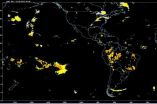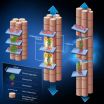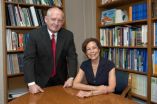(Press-News.org) WHAT:
In a new essay, National Institute of Allergy and Infectious Diseases director Anthony S. Fauci, M.D., and David Morens, M.D., reflect on what has been learned about emerging infectious diseases (EIDs) in the two decades since a major report from the U.S. Institute of Medicine rekindled interest in this important topic.
Heightened awareness of EIDs is itself a countermeasure against disease, note the authors. The emergence of new diseases can now be monitored in real time online through Internet resources such as ProMED. In 2012 alone, such resources kept the scientific community and the public informed about the emergence in the Middle East of a novel disease-causing coronavirus; occurrences of illness at Yosemite National Park caused by a hantavirus; and the emergence in U.S. farm communities of a variant influenza virus (H3N2v) that spread from swine to people. The authors point to advances that have improved the diagnosis, treatment and prevention of EIDs. Rapid sequencing of whole genomes, for example, allows for swift identification of new disease agents. The complex interactions between disease-causing microbes and human hosts are being revealed through approaches that describe entire biological systems holistically (systems biology). The data from such studies can be used to inform the development of drugs or vaccines. Recent appreciation of the sometimes beneficial role of communities of microorganisms dwelling in the gut, mouth, skin and other niches has reshaped the standard notion of infectious diseases as a simple contest between virulent invading pathogens and the human immune system.
The scientists emphasize the need for sustained commitment to developing countermeasures for specific diseases and to basic research that will lead to a greater understanding of infectious diseases and human susceptibility.
ARTICLE:
DM Morens and AS Fauci. Emerging infectious diseases in 2012: 20 years after the Institute of Medicine report. mBio DOI: 10.1128/mBio.00494-12 (2012) (http://mbio.asm.org/content/3/6/e00494-12).
WHO:
NIAID Director Anthony S. Fauci, M.D., and David M. Morens, M.D., senior advisor to the NIAID Director are available to comment.
CONTACT:
To schedule interviews, please contact Anne A. Oplinger, (301) 402-1663, aoplinger@niaid.nih.gov.
###
NIAID conducts and supports research—at NIH, throughout the United States, and worldwide—to study the causes of infectious and immune-mediated diseases, and to develop better means of preventing, diagnosing and treating these illnesses. News releases, fact sheets and other NIAID-related materials are available on the NIAID Web site at http://www.niaid.nih.gov.
About the National Institutes of Health (NIH): NIH, the nation's medical research agency, includes 27 Institutes and Centers and is a component of the U.S. Department of Health and Human Services. NIH is the primary federal agency conducting and supporting basic, clinical, and translational medical research, and is investigating the causes, treatments, and cures for both common and rare diseases. For more information about NIH and its programs, visit http://www.nih.gov/.
NIH...Turning Discovery Into Health
NIH scientists reflect on gains in emerging infectious disease awareness, research and response
2012-12-11
ELSE PRESS RELEASES FROM THIS DATE:
Best of both worlds: Hybrid approach sheds light on crystal structure solution
2012-12-11
Understanding the arrangement of atoms in a solid — one of solids' fundamental properties — is vital to advanced materials research. For decades, two camps of researchers have been working to develop methods to understand these so-called crystal structures. "Solution" methods, championed by experimental researchers, draw on data from diffraction experiments, while "prediction" methods of computational materials scientists bypass experimental data altogether.
While progress has been made, computational scientists still cannot make crystal structure predictions routinely. ...
Weekly dose reduces targeted drug's side effects, but not its activity against ALL
2012-12-11
ATLANTA - A potent chemotherapy agent wrapped within a monoclonal antibody selectively destroys the malignant cells responsible for acute lymphocytic leukemia (ALL) in either weekly or monthly dosing, researchers report at the 54th ASH Annual Meeting and Exposition.
This 'Trojan horse' assault on the cancer cells has significantly increased the response rate among patients with ALL, and now a clinical trial finds that weekly dosing works well and reduces side effects.
"The CD22 antigen is a specific marker for B-cell malignancies and is expressed in more than 90 percent ...
New system for aircraft forecasts potential storm hazards over oceans
2012-12-11
Contact: David Hosansky
hosansky@ucar.edu
303-497-8611
Zhenya Gallon, NCAR/UCAR Media Relations
zhenya@ucar.edu
303-497-8607
National Center for Atmospheric Research/University Corporation for Atmospheric Research
New system for aircraft forecasts potential storm hazards over oceans
BOULDER—The National Center for Atmospheric Research (NCAR) has developed a prototype system to help flights avoid major storms as they travel over remote ocean regions. The 8-hour forecasts of potentially dangerous atmospheric conditions are designed for pilots, air traffic ...
Does changing the price of medicine influence consumers' perceived health risk?
2012-12-11
Consumers assume their risk of getting a serious illness is higher when medications are cheaper because they believe that prices for life-saving products are based on need and not profit, according to a new study in the Journal of Consumer Research.
"When consumers see lower prices for a life-saving product, they infer a higher need and thereby a greater risk that they can contract the disease. On the other hand, higher prices signal that a drug or treatment is inaccessible and thus the risk of getting a disease must not be all that great," write authors Adriana Samper ...
Eating or spending too much? Blame it on Facebook
2012-12-11
Participating in online social networks can have a detrimental effect on consumer well-being by lowering self-control among certain users, according to a new study in the Journal of Consumer Research.
"Using online social networks can have a positive effect on self-esteem and well-being. However, these increased feelings of self-worth can have a detrimental effect on behavior. Because consumers care about the image they present to close friends, social network use enhances self-esteem in users who are focused on close friends while browsing their social network. This ...
Who are you calling old? How elderly consumers negotiate their identities
2012-12-11
Caregivers view elderly consumers as "old" when they can no longer perform everyday consumption activities on their own regardless of their actual age, according to a new study in the Journal of Consumer Research.
"Consumption activities such as shopping, preparing meals, doing housework, going to the doctor, taking medications, and managing money serve as a means of identifying someone as old and a venue for working through conflicts that arise when older consumers who do not identify as old are treated as an 'old person' by family members and service providers," write ...
The current state of lung cancer treatment
2012-12-11
A review in the December issue of the journal Archives of Pathology & Laboratory Medicine by Paul Bunn Jr, MD, University of Colorado Cancer Center investigator and past president of ASCO, IASLC and AACI describes the current state of lung cancer care.
"We're in a new paradigm in which we realize this top cause of cancer deaths is actually a number of related diseases, each potentially with its own cause and cure," Bunn says.
The review describes the shift from blanketing lung cancer with radiation and chemotherapy, to targeting the specific genetic mutations that cause ...
Battling brittle bones... with broccoli and spinach?
2012-12-11
Troy, N.Y. – A new study from engineering researchers at Rensselaer Polytechnic Institute shows, for the first time, how the little-understood protein osteocalcin plays a significant role in the strength of our bones. The findings could lead to new strategies and therapeutics for fighting osteoporosis and lowering the risk of bone fracture.
Funded by the U.S. National Institutes of Health, the study details how fractures in healthy bones begin with the creation of incredibly tiny holes, each measuring only about 500 atoms in diameter, within the bone's mineral structure. ...
Reports assess global student achievement in math, science and reading literacy
2012-12-11
CHESTNUT HILL, Mass. (12-11-12)—Students from East Asian countries, in addition to a select group of European countries, outperformed students around the world in mathematics, science and reading at both the fourth and eighth grades, according to results released Dec. 11 by Lynch School of Education Professors Ina V.S. Mullis and Michael O. Martin, executive directors of the TIMSS & PIRLS International Study Center.
The Trends in International Mathematics and Science Study (TIMSS) is the first global assessment of mathematics and science to provide data about trends over ...
Holiday shopping madness: When do consumers seek to punish fellow shoppers for behaving badly?
2012-12-11
Consumers seek to punish fellow consumers who violate social norms while shopping but also make exceptions depending on the situation, according to a new study in the Journal of Consumer Research.
"Punishment is a complex decision for consumers to make as it is difficult to punish someone but also difficult to look the other way. Consumers do not seem to make these decisions lightly, and a number of interesting factors influence consumer punishment decisions," write authors Lily Lin, Darren W. Dahl (both University of British Columbia), and Jennifer J. Argo (University ...



